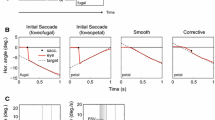Abstract
Smooth pursuit typically includes corrective catch-up saccades, but may also include such intrusive saccades away from the target as anticipatory or large overshooting saccades. We sought to differentiate catch-up from anticipatory and overshooting saccades by their peak velocities, to see whether the higher velocities of visually rather than nonvisually guided saccades in saccadic tasks may be found also in saccades in pursuit. In experiment 1, 12 subjects showed catch-up, anticipatory, and overshooting saccades to comprise 70.4% of all saccades in pursuit of periodic, 30°/s constant-velocity targets. Catch-up saccades were faster than the others. Saccadic tasks were run as well, on 19 subjects, including the 12 whose pursuit data were analyzed, with target-onset, target-remaining (saccade to the remaining target when the other three extinguish), and antisaccade tasks. For 17 of the 19 subjects, antisaccade velocities were lower than for either target-onset or target-remaining tasks. Velocities for the target-remaining task were near those for target onset, indicating that target presence, not its onset, defines visually guided saccades. Error and reaction-time data suggest greater cognitive difficulty for target remaining than for target onset, so that the cognitive difficulty of typical nonvisually guided saccade tasks is not sufficient to produce their lowered velocity. To produce reliably, in each subject, catch-up and anticipatory saccades with comparable amplitude distributions, nine new subjects were asked in experiment 2 to make intentional catch-up and anticipatory saccades in pursuit, and were presented with embedded target jumps to elicit catch-up saccades, all with periodic target trajectories of 15°/s and 30°/s. Velocities of intentional anticipatory saccades were lower than velocities of intentional catch-up saccades, while velocities of intentional and embedded catch-up saccades were similar. Target-onset and remembered-target saccadic tasks were run, showing the expected higher velocity for the target-onset task in each subject. Both experiments demonstrate higher peak velocities for catch-up saccades than for anticipatory saccades, suggesting that cortical structures preferentially involved in nonvisually guided saccades may initiate the anticipatory and overshooting saccades in pursuit.
Similar content being viewed by others
Author information
Authors and Affiliations
Additional information
Received: 1 December 1995 / Accepted: 25 February 1997
Rights and permissions
About this article
Cite this article
Gelder, P., Lebedev, S. & Tsui, W. Peak velocities of visually and nonvisually guided saccades in smooth-pursuit and saccadic tasks. Exp Brain Res 116, 201–215 (1997). https://doi.org/10.1007/PL00005750
Issue Date:
DOI: https://doi.org/10.1007/PL00005750




